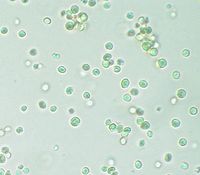
Photo from wikipedia
Nitrogen deprivation (−N) has been used as a technique to promote lipid accumulation in various microalgae. Scenedesmus acutus is a promising oleaginous green microalga that can be cultivated in organic… Click to show full abstract
Nitrogen deprivation (−N) has been used as a technique to promote lipid accumulation in various microalgae. Scenedesmus acutus is a promising oleaginous green microalga that can be cultivated in organic wastewater for biodiesel production. Nevertheless, the molecular mechanisms controlling S. acutus lipid accumulation in response to −N remain unidentified. Physiological study determined that −N reduced cell growth and photosynthetic pigments. On the other hand, it promoted carbohydrate and neutral lipid accumulation. To find the mechanisms underlying lipid accumulation, we performed de novo transcriptome profiling of the non-model S. acutus in response to −N. The transcriptome analysis revealed that glycolysis and starch degradation were up-regulated; on the contrary, gluconeogenesis, photosynthesis, triacylglycerol (TAG) degradation and starch synthesis were down-regulated by −N. Under −N, the carbon flux was shifted toward fatty acid and TAG synthesis, and the down regulation of TAG lipase genes may contribute to TAG accumulation. A comparative analysis of the −N transcriptomes of oleaginous microalgae identified that the down-regulation of multiple lipase genes was a specific mechanism found only in the −N transcriptome of S. acutus. Our study unraveled the mechanisms controlling −N-induced lipid accumulation in S. acutus, and provided new perspectives for the genetic manipulation of biodiesel-producing microalgae.
Journal Title: Scientific Reports
Year Published: 2018
Link to full text (if available)
Share on Social Media: Sign Up to like & get
recommendations!